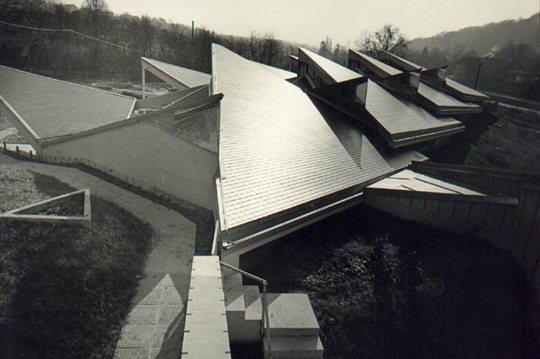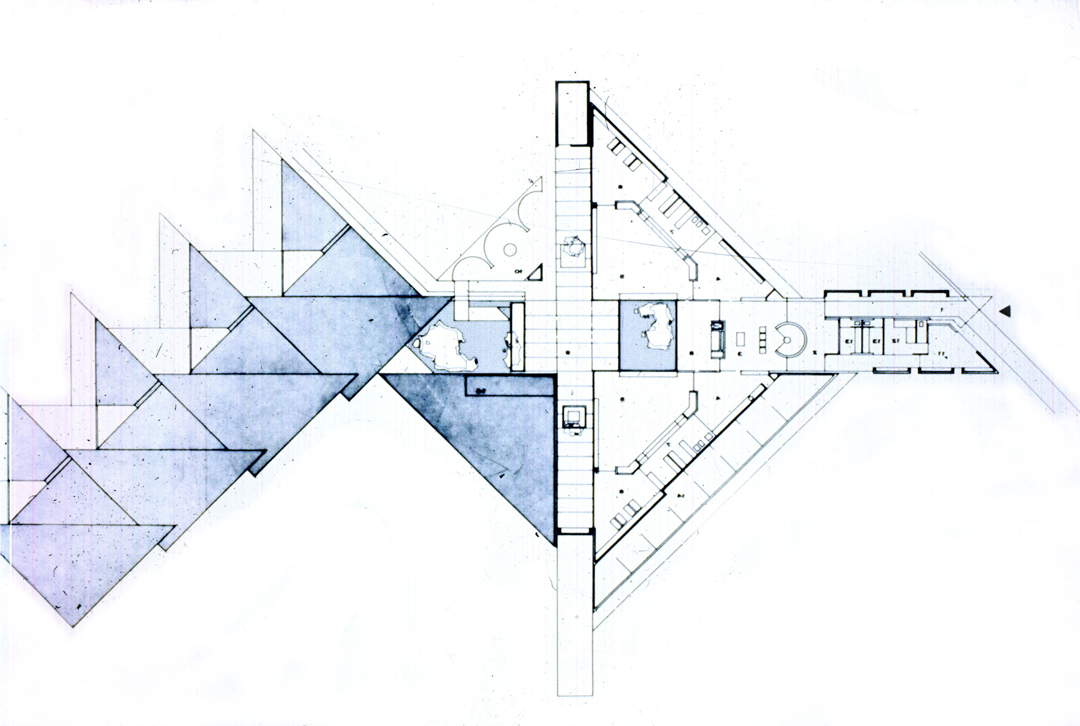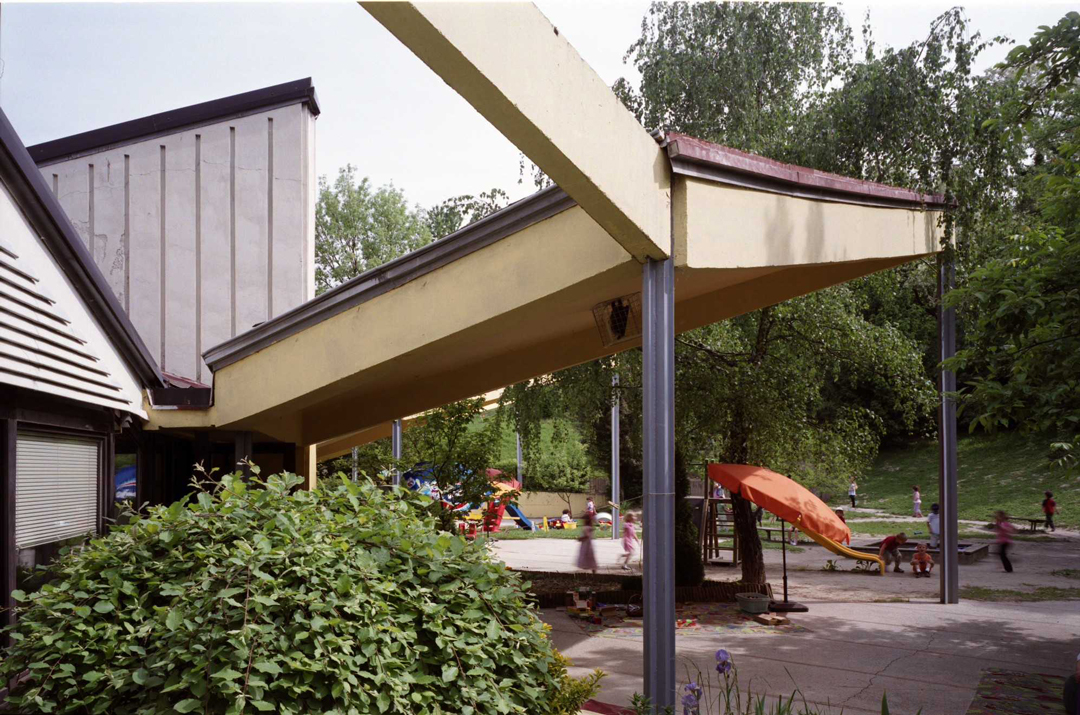Liberated from the constrains of epoch, we return to some weathered works in order to experience them anew, only to be confronted with some universal values that rise above the limits of the circumstances of time and society. As we visit the building of the Mihaljevac Kindergarten and Nursery Centre in Zagreb, designed by the leading Croatian architect Boris Magaš in 1975 we experience pure exaltation with an inspiring piece of architecture. It is the same exaltation we feel when visiting the most memorable buildings regardless of the date of their design and construction, or the location and the cultural space they belong to. While approaching this project intent on being an analytical and objective observer of architecture, we cannot suppress the subjective urge that, faced with a choice of an educational institution for our own child, this would be our building of choice in Zagreb. Certainly a building is but a framework, but it is also an impulse for the extraordinary creative work with children we can detect while visiting it and the kindergarten’s web site at www.vjeverica.hr. The institution is now renamed after the squirrel (vjeverica) and it proudly displays its privilege to raise its children in such a splendid work of architecture.
In order to immediately water down this introductory panegyric to a building and its architect, we should mention the public reception of the project after it won an architectural prize in 1975.[1] The headline read: ‘Public Award for a Public Failure’. Concerned by the shabbily executed finishing touches to the building and the impossibility of carrying out the architect’s full vision with the means of the day, this type of reaction typically addressed the spending of public funds, and architecture in its pure form simply did not stand a chance. Now after 35 years of the building’s atrophy and inappropriate interventions we believe that it is possible to convince the public to protect this work of architecture, and to restore it to its original or even improved state under the aegis of the architect himself. We are convinced that both the architectural community and the children do not need similar convincing.
Cities which are laid out on a stage before a clearly defined topological backdrop somehow feel welcoming and protecting. The mise-en-scène of the city against a natural backdrop brings a sense of safety and gives an instant and lasting sense of coordinates and orientation. The kindergarten rests on one such trajectory between the city of Zagreb and its scenic mountain, at the end of a geological and architectural procession of building leading from the city centre towards the hills. This urban sequence has only recently been filled in the building’s immediate neighbourhood which only emphasizes its idiosyncratic and anticipatory role. The first impression the building gives is of complete immersion into the terrain and an organic fusion with the wider topography stretching all the way to the peak of Sljeme. The building is an evocative interpretation of the landscape itself forming a micro world of broken tecton that embraces its occupants and provides safety.
The architect turns the powerful lines of topographic force into geometric lines to delineate an architecture of complex space, quizzical and not easily comprehended despite its rigid algorithmic geometric concept. The space-making algorithm is based on the manipulation of scale, the first level of manipulation being the relationship of the wider surroundings and the building itself, and then the fractal shifts in scale between the building and its parts. These shifts in scale are the chief generative mechanism with an obvious conceptual and narrative link to a space for rearing children. The critic Antoaneta Pasinović succinctly wrote about the strategy of shifting scales in the magazine Čovjek i Prostor in 1976,[2] coinciding in the same issue with the publication of the architect’s other masterpiece, the football stadium in Split. From the architect himself we are given a detailed description of the horizontal and vertical siting of the served and serviced spaces within the building. But no mention of the architectural added value. As a sign of the time it was perhaps deemed unsuitable to disclose architectural trade secrets, and to open a dialogue on the host of phenomenologies the kindergarten provokes and which set it ahead of its time and cultural space. Professor Magaš anticipated the now common fusion between architecture and landscape with this announcement 35 years ago, but it only remains part of his personal architectural preoccupation and away from the matrix of the time.

The clash of opposing notions is impossible not to notice from today’s perspective: the rigid geometry of the plan and the frontal silhouette of the building on the hill as we experience it driving by, and the labyrinthine, almost puzzle-like complexity found in the interior and its fusion with the terrain around it. In order to marry the planar sense of the layout and section with the complex experience of the whole, we need visual aids and tools to help us reconstruct the precise code of plans and elevations as they relate to the exuberant sequence of the volumes that compose the building. Perhaps we need the aids in our contemporary urge to have instant gratification of seeing and experiencing everything at once, without delay, and in a full simulation of reality. Or we are confronted by the atrophy of our ability to see space as we have become used to the animated visualization of space which make the floor plan and section but atavistic leftovers from time past. Luckily, the kindergarten’s occupants, no doubt bombarded by digital content, do spend a significant portion of their time in a space that calls to be explored, appropriated and understood without any aids.
If we for a moment assume the role of a Beaux Arts disciple and, with the help of a triangle alone, without a computer, attempt to trace the plan in the manner of classical architecture, we would start with the main axes, forming a cardo and decumanus and by diagonal rotation would form the main corps of the building. By doing this we would certainly encounter the universal geometric repertory of classical architecture, perfect proportions and harmony. These central volumes contain the larger programmes of nursery and public spaces, forming a forum at the intersection, in which gatherings, exercises and performances are held. On the upper floor, the nursery rooms are in similar configuration, and due to the slope of the terrain are connected with the outside. Using triangulation from the base, rotated triangle we enter into the ever smaller, fractal segments of the kindergarten units. There are four equal unit modules with complex tectonic links between the inside and outside covered terraces and lawns. The units are slightly shifted from the diagonal in order to free up the south-eastern exposure, while maintaining the main focus of the project on turning away from the public road in front of the building and forming a green oasis on the opposite, wooded side of the slope. The elemental spatial cell is a triangular prism, integral in the large main volumes but segmented in the volumes of the units, where they overlap and rise above each other in different directions. The lofted triangles form an extraordinarily dynamic composition in which the light penetrations deconstruct the volumes fully. By shifting these four units, their layering and connecting by structural beams, the architectural tour de force embodies the kinetic energy which makes the slides and other playground elements in comparison look totally static.

This triangulated composition with its clear and readable plan was compared with a crystalline structure of non-organic matter (A. Pasinović). Yet the fusion of the building with the land and its cellular fragmentation points to a complete marriage between architecture and landscape in an organic sense that reaches beyond the conceptual origins and becomes an aim in itself. Here we witness a Copernican reversal by the architect himself. In 1962 Magaš designed a prototype for a kindergarten which was later used as the background for a series of buildings in Zagreb. The floor plan brought about a perfectly worked out system of functional requirements for such an institution. It was wrapped in a perfect rectangle with a dynamic inner composition of spaces that, like a comet and its tail, arrayed the main public spaces, the central spine and the units alternating with open porches. The proportions of the space appeared close to ideal.
In the Mihaljevac kindergarten the crystal purity of an ideal form is awakened and becomes an organism. As if architecture is seen as a graft by which a given landscape is grafted like a fruit tree in order to improve its qualities. It enables a prefect union of man and nature. The grafting of landscape by architecture and vice versa is particularly seen in the building’s two inner courtyards which are inserted, like any other atrium for that matter, in order to provide light and air to the wide floor spaces, but also to insert direct quotations of the surroundings into the very tissue of the building. It is precisely at this sequence, as we exit from the building onto the man-made hill of the nursery units, that we experience the roofs of the units below, a new sort of landscape that blurs the distinction between the natural and artificial.
From the iconic theatre project in Zenica in collaboration with Vladimir Turina, to the more recent religious buildings by Boris Magaš, the triangle figures as an almost mystical universal shape conducive to a whole range of spatial manipulations following the rules of geometry and enabling us to search for a perfect construct with multiple meanings and associations. At its core however we can build the most complex forms with this shape with the least amount of area and the simplest of formwork and building technique. The underlying method of space-making is closer to geometric operations of surveying or even astral navigation. The notion of triangulation is as relevant as ever as it is at the core of the digital algorithms we use to render or even physically construct spatial models of the highest complexity, such as the hyper-realistic delineations of a human face in a movie by Pixar Studios. With only a ruler, triangle and ink, Magaš anticipates all the hidden calculations at work in a processor used for close simulations of biological and geological formations and understanding the genesis of life forms that are used to invent a new architectural space or ways of fabrication and building. We can clearly recognize the seeds of complex organic forms and digital morphogenesis practices by contemporary avant-garde architects, helped in their practice by the ever more potent computing tools and ever more complicated algorithms. In the kindergarten project Magaš clearly anticipates the mission of future architecture to achieve symbiotic unity with nature and some of the metaphors that will emerge much later than the time of his project.
In the social context that brought about such an inspiring work of architecture, we could argue that the kindergarten expresses the humanistic values of socialist society, which is true to an extent. This line of analysis is quite prevalent in the recent interpretations of the Croatian architecture of the second half of the 20th century. This critical platform is easily promoted in the recent marketplace of architectural criticism as it clearly points to the gap between visionary ideals and the failure to realize them. However, since the socialist model has failed, this type of criticism implicitly acknowledges a certain inferiority complex of so-called socialist culture in comparison to the winning capitalist culture. It is precisely the entire work of architect Boris Magaš, and more pointedly this project, that proves that architecture cannot be simply equated with a singular world view, but that it strives towards the universal and idealistic.

That is always a personal quest. In his search for a cosmic order Magaš always loudly affirms his own work within the context of Croatian contemporary architecture, but he also demonstrates that the universal order of things can only be found on one’s own, as an individual who takes away from his or her culture only to subvert it, to turn it upside down in order to widen its meaning and to create a new pool of knowledge in one’s own medium. By acting as a solo architect in a mass society, or by acting in the global world, in which his stadium project is accepted as a reference point, he does not succumb to the limitations of construction technology or the means of architectural production but steadily practises his craft with the goal of widening knowledge of the absolutes.
Our aim is not to define this particular work of architecture within the framework of an organic classicism or some other possible label or to judge this building as the ultimate pedagogical apparatus to educate children and guide their process of cognition. We point to some issues of the building’s form and phenomenology and see it as a rigorous search for the universal values of space and geometry as a timeless and the highest form of humanism. The ultimate beneficiary of this search is definitely not some divine being but the human being proper, moreover the human in its purest form, the child.
We can rest assured that in the next thirty years some boy or a girl will become an architect and read into this building a new set of parameters in the scale of either subatomic particles or cosmological events, or in between and thus return back to origins.
[1] The Borba Prize for Architecture – Croatia, 1975
[2] ČiP, no. 278 , (5) 1976